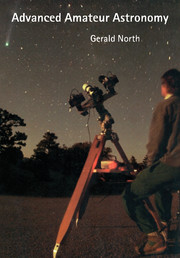Book contents
- Frontmatter
- Contents
- Preface to the second edition
- Preface to the first edition
- Acknowledgements
- 1 Telescope optics
- 2 Atmosphere, seeing, magnification and eyepieces
- 3 Telescope hardware and adjustments
- 4 Astrophotography with the camera
- 5 Astrophotography through the telescope
- 6 Electronic imaging
- 7 The Moon
- 8 The terrestrial planets
- 9 The gas-giant planets
- 10 Asteroids, comets, meteors and aurorae
- 11 The Sun
- 12 Variable stars and novae
- 13 Methods of photometry
- 14 Double stars, star clusters, nebulae, galaxies and supernovae
- 15 Spectroscopy
- 16 Radio astronomy
- 17 Further information
- Appendix: Useful formulae
- Index
5 - Astrophotography through the telescope
Published online by Cambridge University Press: 04 August 2010
- Frontmatter
- Contents
- Preface to the second edition
- Preface to the first edition
- Acknowledgements
- 1 Telescope optics
- 2 Atmosphere, seeing, magnification and eyepieces
- 3 Telescope hardware and adjustments
- 4 Astrophotography with the camera
- 5 Astrophotography through the telescope
- 6 Electronic imaging
- 7 The Moon
- 8 The terrestrial planets
- 9 The gas-giant planets
- 10 Asteroids, comets, meteors and aurorae
- 11 The Sun
- 12 Variable stars and novae
- 13 Methods of photometry
- 14 Double stars, star clusters, nebulae, galaxies and supernovae
- 15 Spectroscopy
- 16 Radio astronomy
- 17 Further information
- Appendix: Useful formulae
- Index
Summary
A natural progression from taking long exposure photographs with a camera mounted piggy-back on a telescope's is to take the photographs through the telescope itself. This chapter follows directly on from the last, where the basic principles were covered. Long exposures through the telescope require particularly good guiding and a steady telescope drive. However, it is also possible to obtain some useful results with a telescope not even equipped with a drive! The specialist topics of comet and solar photography will be covered in Chapters 10 and 11, respectively.
Photography at the principal focus
By ‘principal focus’ I mean the focal plane of a reflector's primary mirror, without the addition of further optics to enlarge the image; and similarly for the focal plane of a refractor. In most cases this means the Newtonian focus of a reflector. The number of amateur reflecting telescopes that have a prime focus position (no secondary mirror) is vanishingly small.
The first problem is how to mount the camera at the focus. Many commercially made telescopes have a focal position which is quite close to the tube wall. Even with an adapter that fits the lensless camera body into the drawtube, the drawtube may not rack far enough in to allow the image to focus on the film. Making or purchasing a ‘low-profile’ focuser may solve the problem. If not, then moving the secondary mirror and the eyepiece focusing mount down the telescope tube towards the primary mirror may be necessary.
- Type
- Chapter
- Information
- Advanced Amateur Astronomy , pp. 105 - 131Publisher: Cambridge University PressPrint publication year: 1997



